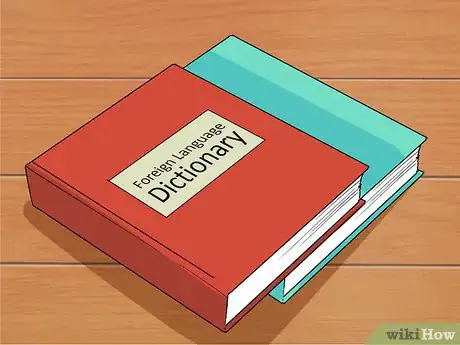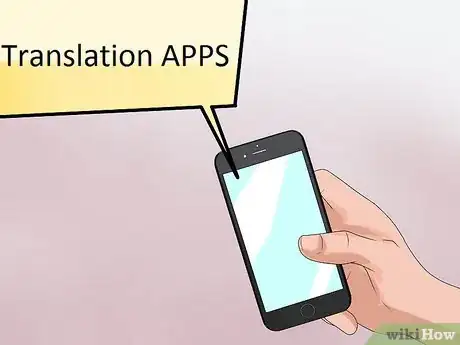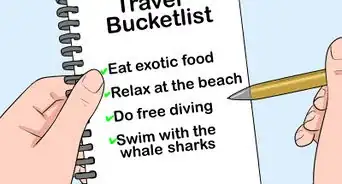This article was co-authored by wikiHow Staff. Our trained team of editors and researchers validate articles for accuracy and comprehensiveness. wikiHow's Content Management Team carefully monitors the work from our editorial staff to ensure that each article is backed by trusted research and meets our high quality standards.
There are 9 references cited in this article, which can be found at the bottom of the page.
wikiHow marks an article as reader-approved once it receives enough positive feedback. In this case, several readers have written to tell us that this article was helpful to them, earning it our reader-approved status.
This article has been viewed 197,854 times.
Learn more...
With hundreds of languages in the world, it's not uncommon to encounter a language barrier during your work, travel, or everyday life. Talking to someone who doesn't speak the same language as you can certainly be challenging. With a little patience and some creativity, however, it is possible to communicate with someone, regardless of whether or not you speak the same language.
Steps
Communicating Verbally
-
1Determine whether there is any possibility of verbal communication. Your first step should be to determine whether you and the person you are talking to know any of the same words. Even a few basic words can help, whether you can understand a few terms in their language or vice versa.
- If you recognize their language and you know a few examples, that's great. If not, ask if the other person understands any English.
- English is the language of travel and business. It is likely that even in parts of the world education is not widespread, many people will still know a few words or phrases in English.[1]
- If that fails, try any other languages you know, even if you only understand a little bit. See if the other person shows any signs of understanding. Just a few words can make communication much easier, even if they're not in either of your native tongues.
-
2Speak slowly. If it seems there is a chance the other person will understand even few words, try speaking to them in English (or any other language both you and they understand a little) very slowly. Slowing down will make it easier for him or her to understand.[2]
- That said, try to keep a normal rhythm. When you slow down your speech, you may have a tendency to get into an odd, stilted rhythm and/or put emphasis on the wrong words. This can make you harder to understand.
- If you speak English with a strong regional accent (e.g. you live in the deep south or have a cockney accent), speaking slowly is doubly important.[3]
Advertisement -
3Don't shout. Many people have a tendency to raise their voices when talking to someone who doesn't speak their language, or doesn't speak it well. This isn't actually helpful. Avoid doing this.[4]
- Shouting will only make you look foolish and may offend the person you are trying to communicate with.
-
4Keep your words simple. Use the simplest words you can to express yourself. Definitely stay away from any jargon, technical language, or similarly complex words.
- Likewise, stay away from the use of idioms or figures of speech. These are expressions that, by definition, are culturally specific, and are not likely to be understood by non-English speakers.
- For example, don't say something is "as easy as pie" or that you you need to "hit the sack." These common American expressions obviously don't have meanings that align with the literal meaning of the words. They are likely to seem bizarre and perplexing to non-native English speakers.[5]
-
5Beware of challenging phrases. Similarly, use the simplest sentence structures you can. Use as few words as possible to get your meaning across.[6]
- Avoid confusing structures, such as questions asked in the negative. Instead of saying: "You don't have any idea what I mean, do you?" ask "Do you understand what I mean?"[7]
-
6Be consistent. Once you've chosen a word for something, don't switch to another term for same thing. This can add confusion and create misunderstandings.
- For example, if you are trying to ask where you can buy some pain medication, stick with that term, don't vary your words and say "aspirin" or "painkillers" or some other synonym a moment later, at least not if the person you are talking to seemed to understand the first term.[8]
-
7Listen actively. Ask questions to make sure the other person is understanding you, and express your understanding when he or she successfully communicates something to you.
- Similarly, be on lookout for signals that she or he does not understand you, such a scrunched brow or the universal "huh?"[9]
-
8Put it in writing. Many people who are just learning English understand things better in written form than via spoken language.[10] If speaking isn't working, it might be worth writing down a few words.
- This also eliminates problems that might come about because of pronunciation issues, especially if you have a strong accent.
- Carrying a small notepad and pen for this purpose when you travel is a good idea.[11]
-
9Be patient and polite. Interactions with someone who doesn't speak your language can be frustrating, both for you and the other person. Be as patient as you can, and try to keep your frustration to yourself.
- Do not laugh at the person, roll your eyes, or anything else that you wouldn't do in polite conversation with someone who does speak your language.[12]
-
10Get a foreign language dictionary or phrasebook. If you are traveling to a country where English isn't common, it's good idea to pick up a dictionary and/or phrasebook that will help you understand and speak a few words and phrases in the dominant language.
- While a dictionary will give you a greater variety of words to choose from, a phrase book will contain useful sentences with the verbs already conjugated correctly. This can make you easier for others to understand.
- Small dictionary/phrasebook combinations are available for travelers via your local bookstore or online.
- Some travel guidebooks including a section of common phrases as well.[13]
Using Other Means of Communication
-
1Use gestures. Whether the person you are trying to communicate with can understand a single word you are saying or not, simple gestures can often be helpful in reinforcing meanings or conveying basic ideas. Use gestures such as pointing at objects that are almost universally understood.[14]
- Using your hands to indicate size, location, and so on can be very helpful.
- Be careful, not all gestures are universal. Some common gestures in America have very different meanings in other places. For example, the common sign for "ok" or "perfect" made by touching the tips of your thumb and forefinger is an offensive gesture in Greece and Turkey. So keep it simple!
-
2Act it out. While it might seem silly, sometimes you can communicate by acting out what you are trying to communicate, like in a game of charades. People might laugh at you, but if you can get your point across, it's probably worth it.[15]
- For example, if you are trying to find a good place to eat, you might act out the motion taking some bites with a fork, then rub your belly and make a contented sound, such as "Mmmmm."
-
3Draw a picture. If you're carrying a notepad and pen or pencil, you may be able to communicate effectively by drawing things. Looking for the bus station? Try doing a quick sketch of a bus.[16]
- You can pass the pad off to the other person and let them respond using a picture too, if that helps.
-
4Use an app. If you have a smart phone and access to the internet, there are numerous translation apps you can use to make conversation easier. Many of these allow you to simply talk into the phone and will translate what you've said to the language of your choice.[17]
- Some of these apps are free. It's a good idea to download one before going on a trip somewhere where English isn't spoken.
Warnings
- Gestures and body language vary across cultures. For example, a head shake is "no" in North America and most of Europe, but conveys an emphatic "yes" in Bulgaria. Stepping into someone's personal space may be friendly in Mexican culture, but could be read as aggression by a Scot. Some gestures can even be read as obscene, depending on the culture. If traveling abroad, look up common gestures in that country.⧼thumbs_response⧽
References
- ↑ https://www.theclassroom.com/make-someone-doesnt-speak-english-well-feel-comfortable-15932.html
- ↑ http://www.slate.com/blogs/lexicon_valley/2014/12/19/language_travel_tips_how_to_talk_to_someone_who_doesn_t_speak_much_english.html
- ↑ https://indianajo.com/learning-a-language.html
- ↑ http://www.slate.com/blogs/lexicon_valley/2014/12/19/language_travel_tips_how_to_talk_to_someone_who_doesn_t_speak_much_english.html
- ↑ http://www.fluentu.com/english/blog/essential-english-idioms/
- ↑ https://indianajo.com/learning-a-language.html
- ↑ http://www.slate.com/blogs/lexicon_valley/2014/12/19/language_travel_tips_how_to_talk_to_someone_who_doesn_t_speak_much_english.html
- ↑ https://indianajo.com/learning-a-language.html
- ↑ http://www.slate.com/blogs/lexicon_valley/2014/12/19/language_travel_tips_how_to_talk_to_someone_who_doesn_t_speak_much_english.html
- ↑ http://www.leadershipcrossroads.com/mat/Communicating%20Across%20Language%20Barriers.pdf
- ↑ http://www.tripinsurance.com/tips/tips-for-communicating-with-non-english-speakers
- ↑ https://indianajo.com/learning-a-language.html
- ↑ https://www.goabroad.com/articles/tips-for-traveling-abroad-first-time
- ↑ http://www.tripinsurance.com/tips/tips-for-communicating-with-non-english-speakers
- ↑ http://travel-made-simple.com/what-if-you-dont-speak-the-language/
- ↑ http://travel-made-simple.com/what-if-you-dont-speak-the-language/
- ↑ http://www.techrepublic.com/blog/five-apps/overcome-the-language-barrier-with-these-five-free-translation-apps/
About This Article
Talking with someone who doesn’t speak your language may seem challenging, but with some creativity and patience, you can make it work. Try to determine if there are any shared words you may both understand, like yes, no, or okay, that you can use to communicate. You will also need to use gestures and pointing to convey what you want to say. It may seem silly, but you can also act out what you want to say. For example, if you’re looking for a good restaurant, you might rub your belly and make motions like you’re taking some bites with a fork. Another option is to try drawing a picture of what you need to say. If these methods don't work, try using a translation app on your phone. To learn how to use a foreign language dictionary to get your message across, read on!











































































